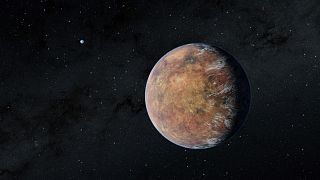
NASA has spotted an exoplanet roughly the size of Earth that orbits within the habitable zone of its star – meaning it could host liquid water on its surface.
The discovery of the planet — named TOI 700 e — was announced in a paper in the journal The Astrophysical Journal Letters.
It was found using data from NASA’s Transiting Exoplanet Survey Satellite (TESS), a space telescope which hunts for exoplanets.
The newly discovered planet is likely to be rocky, according to the experts, which could also make it more likely as a candidate to host life.

Liquid water could also exist on its surface at some point during its planetary lifetime because it is in the habitable zone of its star. This means the temperature could be right on the planet because it is neither too close nor too far from the star.
The observations reveal TOI 700 e is 95 per cent the size of Earth, and it exists in a solar system alongside other potentially habitable planets that were already discovered.
Orbiting a cool M dwarf star named TOI 700, located around 100 light-years away, the planets TOI 700 b, c and d were previously discovered, but to spot TOI 700 e another year of observational data was needed due to its small size and distance.

“If the star was a little closer or the planet a little bigger, we might have been able to spot TOI 700 e in the first year of TESS data,” said Ben Hord, a doctoral candidate at the University of Maryland, College Park and a graduate researcher at NASA’s Goddard Space Flight Center in Greenbelt, Maryland. “But the signal was so faint that we needed the additional year of transit observations to identify it.”
“This is one of only a few systems with multiple, small, habitable-zone planets that we know of,” said Emily Gilbert, a postdoctoral fellow at NASA’s Jet Propulsion Laboratory in Southern California who led the work.
“That makes the TOI 700 system an exciting prospect for additional follow up. Planet e is about 10% smaller than planet d, so the system also shows how additional TESS observations help us find smaller and smaller worlds.”
TOI 700 d also orbits in the habitable zone.
The innermost planet, TOI 700 b, orbits the star every 10 days, while TOI 700 c does so every 16 days. These two planets are believed to be tidally locked, meaning one side is always facing their sun, like the Moon does with the Earth.
TOI 700 d meanwhile takes 28 days to orbit its star.

TESS monitors sections of the sky for around 27 days at a time, allowing the satellite to track changes in the brightness of stars. Dimming light can be caused by a planet crossing in front of it from the satellite’s line of sight.
Finding other systems with Earth-size worlds in this region helps planetary scientists learn more about the history of our own solar system.
Follow-up study of the TOI 700 system with space- and ground-based observatories is ongoing, Gilbert said, and may yield further insights into this rare system.
source:euronews








